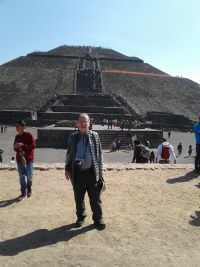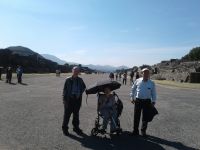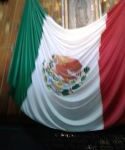January 5, 2019
The recent discovery of a new temple complex nearby (dedicated to the “Flayed” Aztec god—you wore the skins of the sacrificed humans) is a reminder of the rich Meso-American cultures waiting to be discovered, unearthed, and understood.
 What so far has been unearthed is spectacular, as we discovered at Teotihuacan, about 30 miles from Mexico City. A flourishing city of some 200,000 people, what distinguished it were two pyramids, one dedicated to the Sun, the other to the Moon—separated and joined by the Avenue of the Dead. Some of the buildings still have the rich murals and sculptures we had seen in the National Archeological Museum.
What so far has been unearthed is spectacular, as we discovered at Teotihuacan, about 30 miles from Mexico City. A flourishing city of some 200,000 people, what distinguished it were two pyramids, one dedicated to the Sun, the other to the Moon—separated and joined by the Avenue of the Dead. Some of the buildings still have the rich murals and sculptures we had seen in the National Archeological Museum.
Teotihuacan, built originally about 2000 years ago is apparently similar to some of the other sites—such as Chichen Itza, Palenque, and Monte Alban. The scale and scope are impressive. The pyramid of the Sun is the 3rd largest in the world—built as so much of Mesoamerica without metal tools or wheels. Temples once stood at the top, and like its distant cousin, the much smaller mounds at Cahokia (without stone!), left only artefacts with which to construct the use in the past. The site was occupied for over a thousand years, and the Aztecs apparently rediscovered and reused it.
The main avenue (Avenue of the Dead; there’s a real preoccupation with death here—I saw an altar of skulls in the history museum) was once five  kilometers long. What’s been excavated is 2 kilometers, symmetrically balanced with temple-platforms on each side.
kilometers long. What’s been excavated is 2 kilometers, symmetrically balanced with temple-platforms on each side.
There are obviously other mounds nearby, awaiting rescue from the scrub and cactus landscaping. A nearby volcano reminds one that perhaps a reason for the abandonment of Tenochtitlan is a volcanic explosion. The volcano also explains the obsidian, and the use of volcanic stone in the building.

 The other “religious shrine” we visited was the church built to celebrate the miraculous appearance of the Virgin of Guadalupe in 1531. The Spanish (Franciscans were prominent here) had had trouble converting the Meso-Americans. One compromise, our guide suggested, was to use a cross without Jesus outside the churches. The padres could hardly condemn human sacrifices if Christ appeared on a Cross. The other miracle was the appearance of the Virgin, in the body of a Meso-American, promising to protect Mexicans if they were to convert. On the site of the vision, there is a church built around 1750 (interestingly, it had to be stabilized after a recent earthquake, while a companion is leaning to the left from the quake), and a much more modern building was erected in 1976, where the shrine of the Virgin of Guadalupe is housed today. In the churches we have seen since, there is a prominent place given to the Virgin of Guadalupe—and Mexico is at least 85% Catholic today.
The other “religious shrine” we visited was the church built to celebrate the miraculous appearance of the Virgin of Guadalupe in 1531. The Spanish (Franciscans were prominent here) had had trouble converting the Meso-Americans. One compromise, our guide suggested, was to use a cross without Jesus outside the churches. The padres could hardly condemn human sacrifices if Christ appeared on a Cross. The other miracle was the appearance of the Virgin, in the body of a Meso-American, promising to protect Mexicans if they were to convert. On the site of the vision, there is a church built around 1750 (interestingly, it had to be stabilized after a recent earthquake, while a companion is leaning to the left from the quake), and a much more modern building was erected in 1976, where the shrine of the Virgin of Guadalupe is housed today. In the churches we have seen since, there is a prominent place given to the Virgin of Guadalupe—and Mexico is at least 85% Catholic today.
2000 years, at least two religious messages near Mexico City.